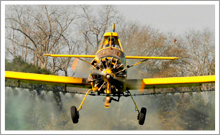| ||||
| | FT News | Inside AOPA | TRAINING PRODUCTS | FINAL EXAM | |||
TRAINING TIPsConvective sigmets
Two words that you heard over the radio got your immediate attention: Convective sigmet 45E has been issued near your route “for a line of severe thunderstorms 15 nautical miles wide, moving from 250 degrees at 15 knots, tops above Flight Level 450. Hail to one inch, gusts to 50 knots possible.” Hail greater than three-quarters of an inch in diameter is always included in a convective sigmet or an urgent pilot report; see the July 17, 2009, Training Tip.
What exactly is a sigmet? It is a National Weather Service contraction that stands for significant meteorological information. A sigmet is an in-flight weather advisory “considered significant to all aircraft,” as explained in Chapter 11 of the Pilot’s Handbook of Aeronautical Knowledge . When such an advisory is concerned with convective weather, the sigmet is named accordingly.
Updating your weather information from the air is not the only way you may learn that a sigmet is in effect. Aviation weather forecasts refer to these weather advisories as well. The AOPA Air Safety Foundation publication Weather Strategies contains a transcript of a telephone weather briefing in which the briefer reviews a convective sigmet such as the one described above with a pilot.
Take some time to familiarize yourself with the information a sigmet contains. Then try your hand at the two questions about sigmets in the August 2008 AOPA Flight Training ’s Final Exam.
Convective or not, the issuance of a sigmet is need-to-know information for any pilot. So stay informed about weather, and be ready with a plan of quick action. YOUR PARTNER IN TRAININGEvery pilot needs to remain vigilant during ground operations. To help ensure that you know where you are in reference to taxiways and runways, always use an airport diagram and mark the runway in use with the heading bug on your heading indicator. Once you're on the runway, verify that the heading indicator (and bug) are aligned with the runway. Pilots should also know the meaning of all airport signs and markings. To help you brush up on signs and markings, review the AOPA Air Safety Foundation's Runway Safety online course and Runway Flash Cards. Free airport diagrams are also available on the foundation's Web site.
Did you know that student pilots who join AOPA are three times more likely to complete their flight training? Membership includes unlimited access to aviation information by phone (800/USA-AOPA, weekdays from 8:30 a.m. to 6 p.m. Eastern time) or from AOPA Flight Training Online or AOPA Online. If you're not already a member, join today and get the pilot's edge. Login information is available online.
FLIGHT TRAINING NEWSLindbergh Foundation extends grant deadlineThe Lindbergh Foundation has extended the deadline for aviation-related grant applications until Oct. 30. The foundation’s grant program seeks entries of aviation/aerospace research projects that balance technological advancements with the preservation of the environment. The $10,580 research grants are given to individuals; projects need not be associated with a university, business, or nonprofit organization. For more information, see the Web site or call 763/576-1596. Stay oriented with new animated quizIn July 1999, John F. Kennedy Jr. succumbed to spatial disorientation in the evening haze off Cape Cod, sending his Piper Saratoga into a tight, high-speed spiral that ended in tragedy. In the decade that's followed, nearly 300 other pilots—some of them instrument rated—have similarly lost their bearings in the soup, and many lost their lives. Challenge your knowledge of spatial disorientation with the latest interactive safety quiz from the AOPA Air Safety Foundation, which uses flight simulator animation to illustrate how quickly an accident can develop—and how you can avoid a similar fate. ERAU has busy AirVenture scheduleEmbry-Riddle Aeronautical University will have a big presence at EAA AirVenture 2009 in Oshkosh, Wis. The university is sponsoring aerobatic pilot Matt Chapman, who will fly a CAP 580 called the Embry-Riddle Eagle. On display will be two training aircraft, a Diamond DA42 and Cessna 172, both equipped with Garmin G1000 glass cockpit displays. Aviation entrepreneur and airshow performer Jamail Larkins will speak July 31 during a “Lunch with Embry-Riddle” for middle- and high-school students. Also, the university will have on display its jet-powered dragster, and participants can meet its driver, Elaine Larsen. Jacksonville University gets training softwareJacksonville University’s Division of Aeronautics recently received a donated regional jet software training program. Donor CPat of Houston, Texas, said the ERJ 145 aircraft systems training program is a comprehensive, self-paced learning tool that will maximize the amount of learning achieved and save students money. Inside AOPACalling all potential pilots to AirVentureAre you bringing a potential pilot to EAA AirVenture? If not, why not? Literally acres of airplanes on the show grounds will spark the imagination of anyone who’s ever wanted to take to the skies. AirVenture has an entire exhibit devoted to aspiring pilots, and AOPA will help get them started right. Bring your wannabe pilots to our Let’s Go Flying and AOPA Flight Training booth within the Learn to Fly Discovery Center, located on the southwest corner of AeroShell Square. Pilots in all levels of training are welcome to stop and see what’s new in the world of flight instruction. Read more >> Chinese delegation visits AOPAEleven delegates from the Civil Aviation Administration of China (CAAC), their interpreter, and other guests visited AOPA headquarters in Frederick, Md., on July 16 as part of a 12-day trip to research general aviation in the United States. A high point for the group, charged with developing general aviation in China, came when the delegates got to fly in GA airplanes, including the 2009 Let’s Go Flying Sweepstakes Cirrus. For many, it was their first opportunity to do so. Read more >> Four Steps to Summit SavingsRegistration is open for AOPA Aviation Summit, and it’s time to start planning your trip to Tampa, Fla., for Nov. 5 through 7. AOPA offers a variety of programs that have been designed to help you plan an exciting, budget-friendly experience for the entire family. Just follow our four steps to Summit savings. Then watch a short video of the attractions in the Tampa area. TRAINING PRODUCTSSporty’s offers plotter bundleNeed a new plotter? How about three? Sporty’s offers all three of its pilot plotters—sectional, world aeronautical chart, and instrument—in a bundle that saves you money over purchasing the three separately. All carry a lifetime guarantee: If they warp or break, Sporty’s will replace them free of charge. The set sells for $11.95. Order online or call 800/SPORTYS.
Note: Products listed have not been evaluated by ePilot editors unless otherwise noted. AOPA assumes no responsibility for products or services listed or for claims or actions by manufacturers or vendors. FINAL EXAMQuestion: I am planning a flight into a small, nontowered field. Looking in the Airport/Facility Directory, I noticed that there is both a unicom frequency and a CTAF. Can you tell me what the difference between these two frequencies is and which one I should use to announce my position?
Answer: CTAF is the common traffic advisory frequency. This is the primary and preferred frequency for providing position reports while flying at or near an airport. The unicom frequency is shortened from "universal communications." This is the frequency you would use to communicate with the FBO or airport itself. You can use the unicom frequency to inquire about the preferred runway, wind direction, and other pertinent information. For more information on radio communications, check out the AOPA Air Safety foundation’s newest interactive course, Say It Right: Mastering Radio Communication.
Got a question for our technical services staff? E-mail [email protected] or call the Pilot Information Center, 800/872-2672. Don't forget the online archive of "Final Exam" questions and answers, searchable by keyword or topic. what's new onlineReady to give a pirep? Don’t tell us your altitude and the weather you’re encountering. Tell us about your adventurous flight as a whole! Our new AOPA PiReps is an area where you can publish your own stories and adventures right on AOPA Online. Picture Perfect
AVIATION EVENTS & WEATHER To submit an event or to search all events in the calendar, visit AOPA Online. For airport details, including FBO fuel prices, see AOPA's Airport Directory Online. Flight Instructor Refresher ClinicsThe next AOPA Air Safety Foundation Flight Instructor Refresher Clinics are scheduled in Costa Mesa, Calif., Atlanta, Ga., and Champaign, Ill., Aug. 15 and 16; Reno, Nev., and Allentown, Pa., Aug. 22 and 23; Fort Worth, Texas, Aug. 29 and 30; Phoenix, Ariz., and Sacramento, Calif., Sept. 12 and 13. For a complete schedule, see AOPA Online.
Can't make it in person? Sign up for the CFI Refresher Online. AOPA Air Safety Foundation Safety SeminarsAOPA Air Safety Foundation Safety Seminars are scheduled in Oshkosh, Wis., July 29, 30, and 31; Germantown, Tenn., Aug. 31; Nashville, Tenn., Sept. 1; Maryville, Tenn., Sept. 3. Topics vary—for details and a complete schedule, see AOPA Online. | Got news? Contact ePilot. Having difficulty using this service? Visit the ePilot Frequently Asked Questions now at AOPA Online or write to [email protected]. |
| Member Tools : Send feedback | Update member profile | Change email address | Unsubscribe | ePilot Archive Editorial Team : ePilot Flight Training Editor : Jill Tallman | ePilot Editor: Alyssa Miller | Contributor: Alton Marsh |

 The weather looked great when you launched on today’s solo cross country. There was a cold front headed into the area, your weather briefer said, but frontal passage and any associated weather activity was not expected until tomorrow. But as the day wore on, those typical fair-weather cumulus clouds seemed to take on a more ominous appearance, growing higher and darker. Acting on your gut feeling that weather changes might be afoot, you dialed in a HIWAS frequency or contacted Flight Service by radio for an update. HIWAS was discussed in the Aug. 22, 2003,
The weather looked great when you launched on today’s solo cross country. There was a cold front headed into the area, your weather briefer said, but frontal passage and any associated weather activity was not expected until tomorrow. But as the day wore on, those typical fair-weather cumulus clouds seemed to take on a more ominous appearance, growing higher and darker. Acting on your gut feeling that weather changes might be afoot, you dialed in a HIWAS frequency or contacted Flight Service by radio for an update. HIWAS was discussed in the Aug. 22, 2003,  Pilots love to take photos, and they love to share them with other pilots. Now you can upload your flying photos to our
Pilots love to take photos, and they love to share them with other pilots. Now you can upload your flying photos to our 

